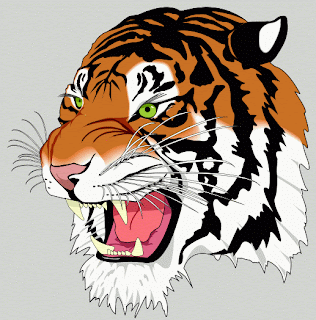SVG is an open standard, human readable and appears to play head to head with FLASH. There are many comparisons of the technologies available on the web, written fom different points of view such as this one. However, the comparison states FLASH does not support filters which FLASH 10 now does.
 The famous tiger image above is a GIF image. However, it is rendered from a vector language called SVG. My blog provider does not support SVG files or I could have embedded that image as an SVG file directly into the web page.
The famous tiger image above is a GIF image. However, it is rendered from a vector language called SVG. My blog provider does not support SVG files or I could have embedded that image as an SVG file directly into the web page.SVG supports Java and JSRs are available that give language bindings (eg JSR 287 language bindings for Tiny 1.2) that allow for creating SVG files dynamically and rendering them.
One proponent of SVG in the set top box world is IPTV solution provider Dreampark. Dreampark, based in Sweden, offer a scalable user interface for IPTV. I was able to see the demo at IPTV world Forum 2009. The demo uses non-rotated (axis aligned if you like) boxes and images and text. Using scaling some psuedo-3D was present. It was not clear if the text scaled from the demo. So it appears the SVG from Dreampark is connected directly to the blitter and limited to the functionality it provides if a smooth, fast user experience is required. Of course over time, like FLASH, the vector functionality, such as lines and polygons, will be available as 3D hardware supporting Open-VG hits the market.
Ikivo also supply SVG for mobile devices and offer Enrich Mobile TV as a product. This is a user interface suite based on SVG for mobile TV. An example from their user interface is shown below.

Adobe meantime support SVG output from their Creative Tool suite. This means that whichever solution is chosen Adobe still win, though of course FLASH offers more opportunity to Adobe for additional license fees. And there is one of the real deciding factor between these two vector graphics languages: business. The licensing model for FLASH on set top boxes is not clear to me yet and I wonder if it is clear to anyone. Designers most likely will pick FLASH if they can but just how much will it add to the cost of an STB?
So in conclusion, FLASH and SVG offer similar functionality. FLASH is proprietary but has momentum in the press and with chip manufacturers. There are however a few companies using SVG for user interfaces for TV, Dreampark being the most significant. The license model is unclear for FLASH and once this is known the business choice between SVG and FLASH will become much more obvious.

1 comment:
SVG has quite some momentum in the press lately: 2 recurring items are:
- SVGWeb brings SVG to IE without needing a new plug-in, in a short time the little video about the project (including a Google engineer) has been watched about 20,000 times.
- Google this year hosts the SVG world conference, with Oct.2 a presentation of the above mentioned SVGWeb among many other interesting subjects: https://www.svgopen.org/2009/registration.php?section=conference_schedule
Post a Comment